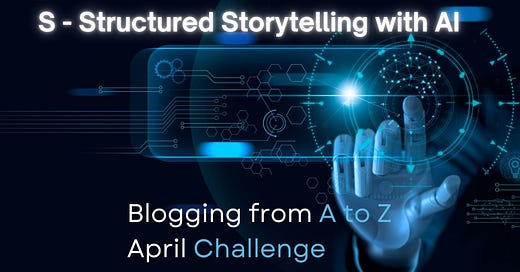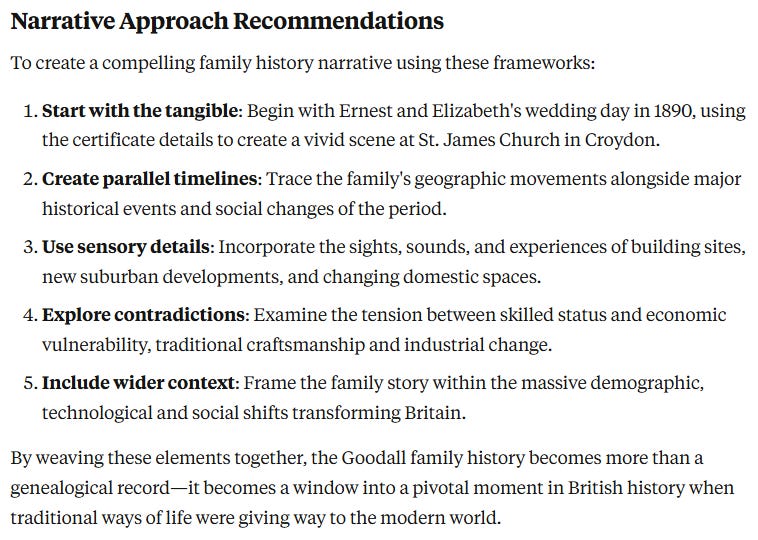Have you ever read ancestral postings that start with the names, dates, and ties of these ancestors to the writer? As genealogists, we are interested in tracking the ancestry of others through blog entries, websites, and various types of family archives. Will they communicate with our family, friends, and descendants for more than the first few paragraphs? As family historians, we owe it to our ancestors to tell stories about their lives and experiences that engage, inspire, or change the way they perceive their ancestry.
However, that is not an easy task! We might stumble over an opening paragraph, confuse the reader with too many facts, or worse, leave them disappointed and yawning! We need some tools to help us structure our storytelling, a structure that includes scenes, subplots, and story arcs, the essential elements of a good story.
AI-Generated Scenes, Subplots, and Story Arcs for Family History
Names, dates, and places form the skeleton of genealogy research, but it's the stories that breathe life into our ancestors. Many family historians excel at research but struggle with transforming their discoveries into engaging narratives. Artificial intelligence now offers powerful tools for structured storytelling, helping genealogists craft compelling family histories through three key narrative elements: scenes, subplots, and story arcs.
Building Blocks of Ancestral Narratives
Before exploring AI applications, let's understand these core storytelling components:
Scenes are vivid moments in time—a wedding day, an immigration journey, or a pivotal decision. Scenes engage the senses and emotions, making ancestors' experiences tangible to modern readers.
Subplots are the interconnected threads that run alongside the main family narrative—occupational histories, military service, community involvement, or educational pursuits that provide depth and context.
Story arcs are the larger narrative trajectories that give meaning to individual events—the journey from poverty to prosperity, the quest for religious freedom, or the adaptation to a new culture across generations.
Together, these elements transform disconnected genealogical facts into coherent narratives that resonate with readers. Join me on my journey into writing engaging ancestral stories with the help of my AI squad of assistants.
AI-Generated Scenes: Bring Moments to Life
Traditional family histories often struggle to recreate specific moments in ancestors' lives due to limited information. AI excels at generating historically accurate scene reconstructions based on available data.
AI Enhances Scene Creation:
Contextual Detail Generation: AI can describe environmental details like weather conditions, typical street scenes, or home interiors based on specific locations and periods.
Sensory Element Suggestions: AI suggests sounds, smells, tastes, and textures relevant to historical contexts, making scenes immersive.
Dialogue Construction: For significant events, AI can create plausible dialogue based on historical speech patterns, educational levels, and cultural backgrounds.
Emotional Landscape Mapping: AI suggests likely emotional responses based on historical circumstances, helping writers convey ancestors' inner experiences.
Case Study: Opening scene for the story of Great Aunt Elizabeth
I uploaded my notes on Elizabeth Ann Robinson and used this prompt with Claude.
Claude’s first draft begins like this:
Now that reads quite well, but still too much fact, and not enough story. So my next prompt was:
The response this time is much more engaging, as it brings in the contextual detail, sensory elements, dialogue, and emotion.
AI-Enhanced Subplots: Weaving Rich Contextual Threads
Family histories often center on basic life events while overlooking rich subplot opportunities. AI helps identify and develop these complementary narratives:
How AI Strengthens Subplot Development:
Occupation Analysis: AI provides detailed information about historical professions, including daily routines, challenges, technologies, and social standings associated with ancestral occupations.
Historical Event Integration: AI identifies relevant historical events that would have affected your ancestors and suggests ways to integrate these into your family narrative.
Community Connection Mapping: AI helps reconstruct community relationships and social networks that influenced your ancestors' lives.
Cultural Practice Exploration: AI offers insights into religious observances, cultural traditions, and social customs practiced by your ancestors.
Case Study continued: …
Curious to know how the ‘Regent Canal Tragedy’ might have impacted my Goodall family, I prompted Claude with this:
Claude’s response gave me another scene infused with historical context and community connections.
The next paragraph gave me my next investigative strategy to further connect these two families.
I needed to find Ernest Goodall’s cousins and follow their migration to North London. One thing I knew about Ernest was his occupation: builder. He and Elizabeth had moved from Croydon to Enfield in the latter part of the 1890s, and he had established his building business and catered for the growing urban developments at Enfield.
Ms Perplexity provided me with more details of the 1890s Building Boom in Enfield District, North London, such as:
But this did not answer my question: were these two Goodall families connected?
AI-Crafted Story Arcs: Finding Meaning Across Generations
Perhaps most powerfully, AI excels at identifying narrative patterns across generations—the overarching story arcs that give meaning to individual lives:
How AI Identifies and Develops Story Arcs:
Pattern Recognition: AI analyzes family data to identify recurring themes, trends, and trajectories across generations.
Thematic Suggestion: Based on identified patterns, AI suggests compelling thematic frameworks that could structure your family narrative.
Historical Context Integration: AI places family trajectories within broader historical movements and social changes.
Turning Point Identification: AI highlights pivotal moments that altered family trajectories, helping structure narratives around key decision points.
Practical Implementation: A Three-Phase AI Storytelling Approach
Phase 1: Scene Generation
Input factual information about a specific ancestral event into your AI assistant
Request contextual enhancement with period-appropriate details
Ask for sensory element suggestions to make the scene immersive
Review for historical accuracy and family alignment
Example Prompt: "Create a scene describing my great-grandfather's experience as a new immigrant working his first day at the textile mill in Lawrence, Massachusetts in 1912. Include period-appropriate sensory details and contextual information about working conditions."
Phase 2: Subplot Exploration
Identify potential subplot themes related to your family history
Request AI analysis of how these subplots might have affected your ancestors
Ask for integration suggestions to connect subplots with your main narrative
Develop the most compelling subplots with additional research
Example Prompt: "My ancestors were tenant farmers in Ireland before immigrating to America during the Potato Famine. Suggest subplots related to land tenure systems, agricultural practices, and landlord-tenant relationships that would enhance understanding of their pre-immigration experience."
Phase 3: Story Arc Development
Input multi-generational family information into your AI assistant
Request pattern analysis across generations
Ask for thematic framework suggestions based on identified patterns
Select and refine the most meaningful arc for your family narrative
Case Study continued …
In phase 3 of my AI-assisted storytelling, I provided Claude with details of my Goodall family (a series of census records and a marriage certificate) and asked for a thematic framework based on identified patterns in occupation for Ernest James Goodall and his father, Stephen Goodall.
Claude created a new thematic story arc and provided some key insights:
Exploring the ‘artefact’ created by Claude, I unpacked his advice on what to do next.
Now I can plan, plot, and write the story of my Great Aunt Elizabeth, and create a meaningful and engaging link between the past and the present for my descendants. This will be a work of AI-assisted structured storytelling and will be published in my family history archives as part of the blog posts at WeAre.xyz. It will appear in the Forged in Time: Volume 2 blog.
Note: Stay tuned to my posts on the A to Z of AI in Genealogy for clues and links to her story. If you are keen to see where her story will be growing, then head over to her profile page here.
Ethical Considerations in AI-Enhanced Storytelling
While AI offers powerful storytelling assistance, responsible family historians should observe important ethical boundaries:
Clearly distinguish fact from plausible fiction in your narratives
Avoid projecting modern values onto historical figures
Respect ancestral privacy and dignity when exploring sensitive topics
Maintain cultural sensitivity when depicting ancestral traditions or beliefs
Acknowledge AI assistance in your creation process
AI in Family History Storytelling
As AI continues to evolve, we can anticipate several exciting developments:
Personalized narrative generation tailored to specific audience interests and reading levels
Interactive storytelling experiences that allow readers to explore different aspects of family history
Visual scene reconstruction using AI image generation based on historical details
Voice synthesis that could recreate ancestral dialects and speech patterns for audio narratives
The most effective approach combines AI's analytical and creative capabilities with the family historian's personal connection, ethical judgment, and contextual knowledge. Together, they can create structured narratives that honor ancestral experiences while engaging contemporary audiences.
Through scenes that immerse, subplots that enrich, and story arcs that illuminate, AI-enhanced storytelling transforms genealogical research from fact collection into meaningful family narratives that will captivate generations to come.
Ready to elevate your genealogy research with AI? Come and learn how to become an AI-skilled ancestral storyteller in the course, "Beyond the Pen: Using AI to Transform Ancestral Storytelling." Discover practical techniques and ethical approaches to incorporating AI into your family history work. Join us at Beyond the Pen and transform how you preserve your family's legacy!
How have you used AI to enhance your family storytelling? Which element—scenes, subplots, or story arcs—do you find most challenging to develop? Share your experiences in the comments below!



















Thank you for allowing us to "eavesdrop in" on your process using AI. It's fascinating to see how the story is improved with each step. I will be doing some experimenting with my own stories to see how much I can improve them!